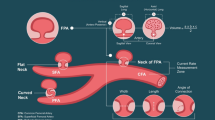Abstract
Nonsurgical closure of femoral artery pseudoaneurysm (PSA), using ultrasound guidance and compression with the ultrasound probe or a C-clamp, has been previously described. We report a patient in whom a different compression device was used (the FemostopTM) which also allows direct ultrasound visualization of the PSA and femoral vessels at the site of compression. This resulted in adequate PSA with preservation of flow in both artery and vein throughout the procedure.
Similar content being viewed by others
References
Wyman RM, Safian RD, Portway V, Skillman JJ, McKay RG, Baim DS. Current complications of diagnostic and therapeutic cardiac catheterization. J Am Coll Cardiol 1988; 12: 1400–6.
Babu SC, Piccorelli GO, Shah PM, Stein JH, Clauss RH. Incidence and results of arterial complications among 16,530 patients undergoing cardiac catheterization. J Vasc Surg 1989; 10: 113–6.
Altin RS, Flicker S, Naidech HJ. Pseudoaneurysm and arteriovenous fistula after femoral artery catheterization: association with low femoral punctures. Am J Radiol 1989; 152: 629–31.
Oweida SW, Roubin GS, Smith RB, Salam AA. Postcatheterization vascular complications associated with percutaneous transluminal coronary angioplasty. J Vasc Surg 1990; 12: 310–5.
Kresowik TF, Khoury MD, Miller BV, Winniford MD, Shamma AR, Sharp WJ, Blecha MB, Corson JD. A prospective study of the incidence and natural history of femoral vascular complications after percutaneous transluminal coronary angioplasty. J Vasc Surg 1991; 13: 328–36.
Agrawal SK, Pinheiro L, Roubin GS, Heam JA, Cannon AD, Macander PJ, Barnes JL, Dean LS, Nanda NC. Nonsurgical closure of femoral pseudoaneurysms complicating cardiac catheterization and percutaneous transluminal coronary angioplasty. J Am Coll Cardiol 1992; 20: 610–5.
Shapiro M, Cohen HL, Crystal K, Katz K. Ultrasound guided compression of femoral artery pseudoaneurysm. J Ultrasound Med 1992; 11: 182–3.
Fellmeth BD, Buckner NK, Ferreira JA, Rooker KT, Parsons PM, Brown PR. Postcatheterization femoral artery injuries: repair with color flow US guidance and C clamp assistance. Radiology 1992; 182: 570–2.
Author information
Authors and Affiliations
Rights and permissions
About this article
Cite this article
Sabri, N., Eddy, P., Traverso, R. et al. Closure of a persistant femoral artery pseudoaneurysm complicating coronary angioplasty using the femostop compression device and direct ultrasound visualization. Int J Cardiac Imag 11, 273–275 (1995). https://doi.org/10.1007/BF01145196
Accepted:
Issue Date:
DOI: https://doi.org/10.1007/BF01145196




